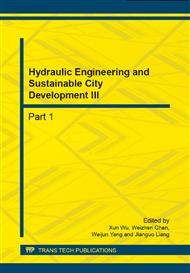p.217
p.222
p.226
p.232
p.236
p.241
p.246
p.251
p.255
Application of Permeable Spur Dike in Mountain River Training
Abstract:
Based on the investigation and indoor experiment, the flow structure and properties of erosion or deposition associated with permeable spur dike were researched. According to the new demands about engineering structure in mountain rivers regulation, the potential action of permeable spur dike in mountain river training was analyzed. The results can be showed that, as the permeable structure, the influence of permeable spur dike to main flow and flood level is less than the solid one, and the local scour depth is less too, so the permeable spur dike has larger safety. In the back of permeable spur dike, it can form a slow flow field, instead of a circumfluence field, and the deposition volume is less than solid one, so the steady slow flow field can benefit to the small aquatic animal lives. The pervious rate can be adjusted to complete training goals when the project faces to different training demands. And the material of spur dike is not limited, it can use the local materials to build, which can reduce the construction cost. The permeable spur dike have a good applicability in the control of mountain river, it can meet the requirements of flood prevention, ecology, environment, cost saving and so on, it have a greatly application prospect.
Info:
Periodical:
Pages:
236-240
Citation:
Online since:
September 2014
Authors:
Keywords:
Price:
Сopyright:
© 2014 Trans Tech Publications Ltd. All Rights Reserved
Share:
Citation:


